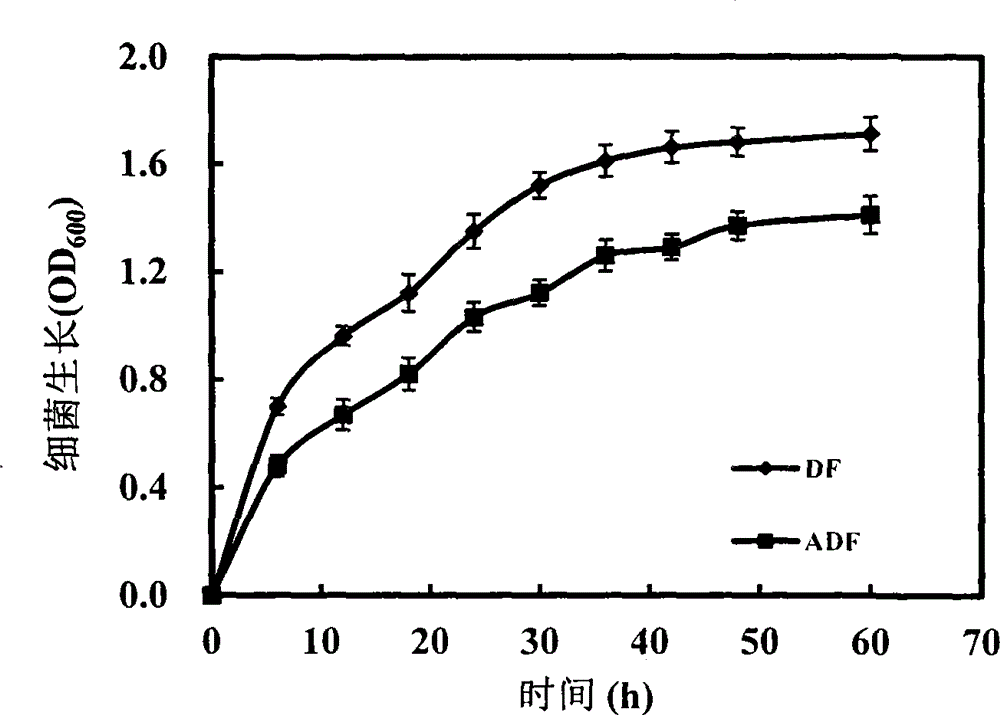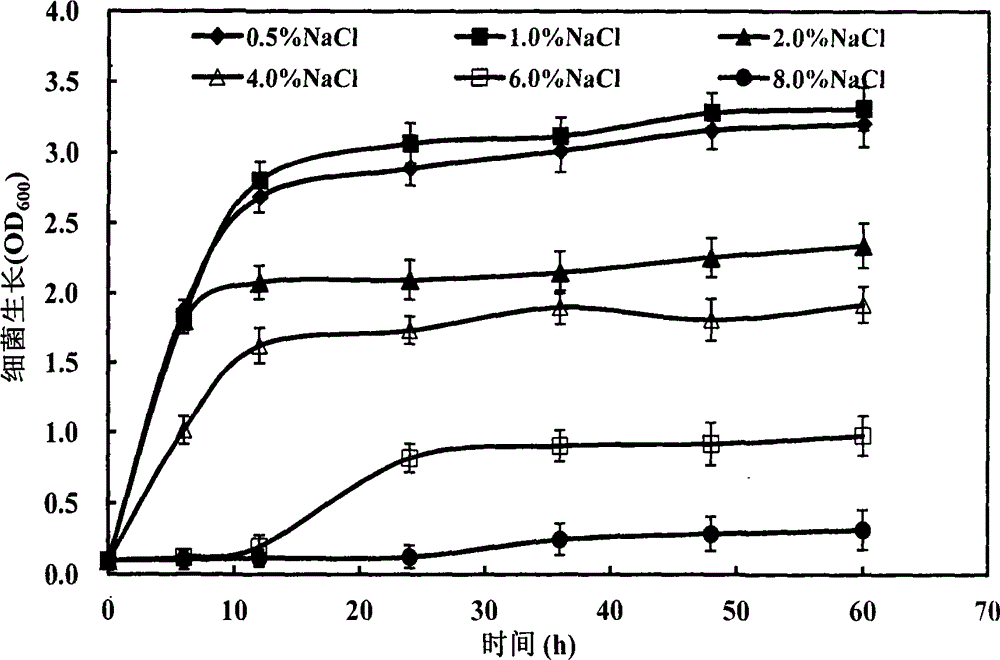Screening method and application of Raoultella planticola strain SRPG-4 producing ACC (1-aminocyclopropane-1-carboxylic acid) deaminase activity
A deaminase and strain technology, which is applied in the field of agricultural biology to achieve the effects of strong environmental adaptability, stable effect, good ecological benefits and social benefits
- Summary
- Abstract
- Description
- Claims
- Application Information
AI Technical Summary
Problems solved by technology
Method used
Image
Examples
Embodiment 1
[0020] Embodiment 1: have the screening and identification of ACC deaminase bacterial strain
[0021] 1. DF liquid medium:
[0022] Component one: H 3 BO 3 10mg, MnSO 4 ·H 2 O 11.19 mg, ZnSO 4 ·7H 2 O 124.6 mg, CuSO 4 ·5H 2 O 78.22 mg, MoO 3 Dissolve more than 10mg in 100mL sterilized distilled water and store at -4°C;
[0023] Component two: FeSO 4 ·7H 2 O (100mg) dissolved in 10ml sterilized distilled water, stored at -4°C;
[0024] Take 0.1 mL each of the above component 1 and component 2 solutions, and then add KH 2 PO 4 4.0g, Na 2 HPO 4 6.0g, MgSO 4 ·7H 2O 0.2g, glucose 2.0g, gluconic acid 2.0g, citric acid 2.0g, (NH 4 ) 2 SO 4 2.0g, H 2 O 1000ml.
[0025] 2. ADF medium:
[0026] The (NH 4 ) 2 SO 4 Replace it with ACC. ACC cannot be sterilized by high temperature. When using it, first make ACC into a mother solution with a concentration of 0.5M, sterilize it through a 0.2μm bacterial filter, and add the mother solution at 6mL / L to the DF aft...
Embodiment 2
[0055] Example 2: Culture characteristics of R. planticola SRPG-4
[0056] Pick a single colony from the ADF plate, re-inoculate the screened strains in DF and ADF culture medium, measure the optical density at 600nm, and draw the growth curve of each strain.
[0057] figure 1 It shows that the strain SRPG-4 can grow normally in both DF and ADF medium. At the same time, the cell density of SRPG-4 in ADF medium is lower than that in DF medium, but the growth trend is basically the same, which also shows that the strain SRPG -4 can make good use of ACC as nutrients for growth.
Embodiment 3
[0058] Embodiment 3: the salt tolerance test of R.planticola SRPG-4
[0059] Using the shake flask culture growth curve method, different NaCl concentrations (0.5%, 1.0%, 2.0%, 4.0%, 6.0% and 8.0%) were set to measure the salt tolerance of the SRPG-4 strain. image 3 As shown, the results show that when the salt concentration does not exceed 4.0%, the time to enter the plateau is more consistent, indicating that the strain SRPG-4 has good tolerance, but when the salt concentration exceeds 2%, the bacterial biomass lower. SRPG-4 grew very slowly when the salt concentration was 6.0%, and the bacterial concentration was also very low, and it entered a plateau after 24 hours. When the salt concentration was 8.0%, the bacteria almost stopped growing. It shows that the strain SRPG-4 will not affect the survival of the strain when the soil salinity does not exceed 2.0%. Because the salt content of secondary salinized soil or salinized soil capable of growing crops is generally wit...
PUM
 Login to View More
Login to View More Abstract
Description
Claims
Application Information
 Login to View More
Login to View More - R&D
- Intellectual Property
- Life Sciences
- Materials
- Tech Scout
- Unparalleled Data Quality
- Higher Quality Content
- 60% Fewer Hallucinations
Browse by: Latest US Patents, China's latest patents, Technical Efficacy Thesaurus, Application Domain, Technology Topic, Popular Technical Reports.
© 2025 PatSnap. All rights reserved.Legal|Privacy policy|Modern Slavery Act Transparency Statement|Sitemap|About US| Contact US: help@patsnap.com



